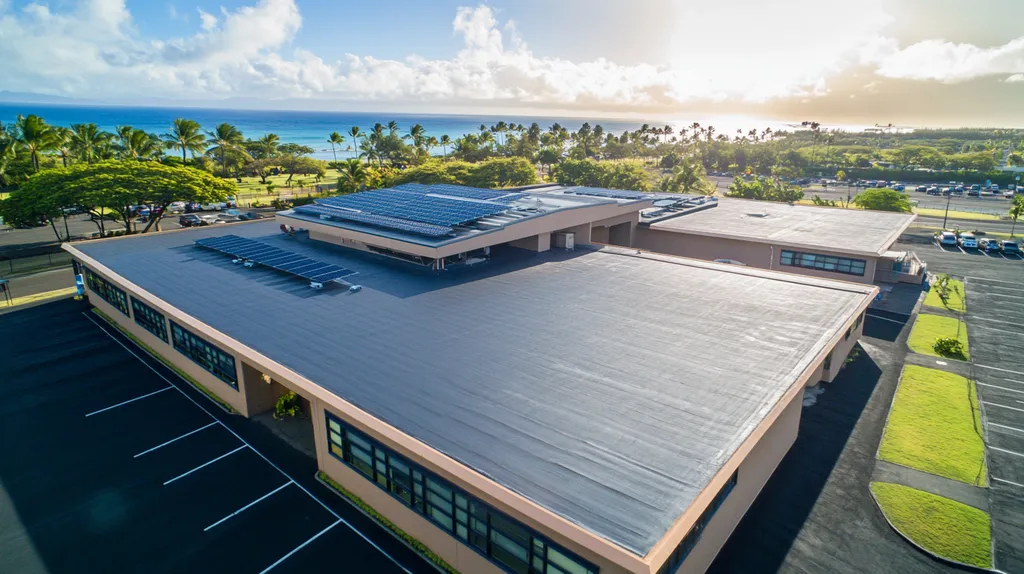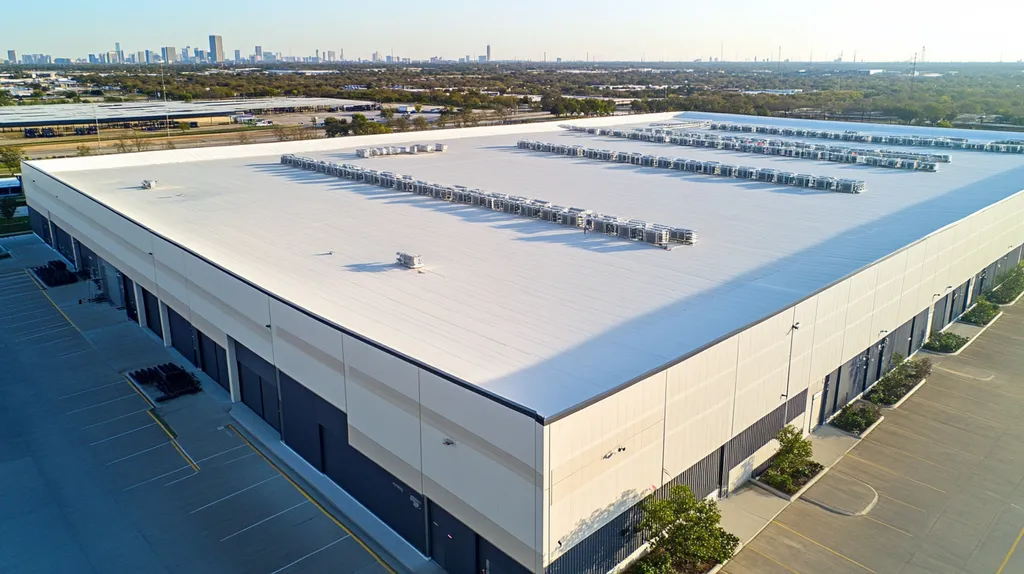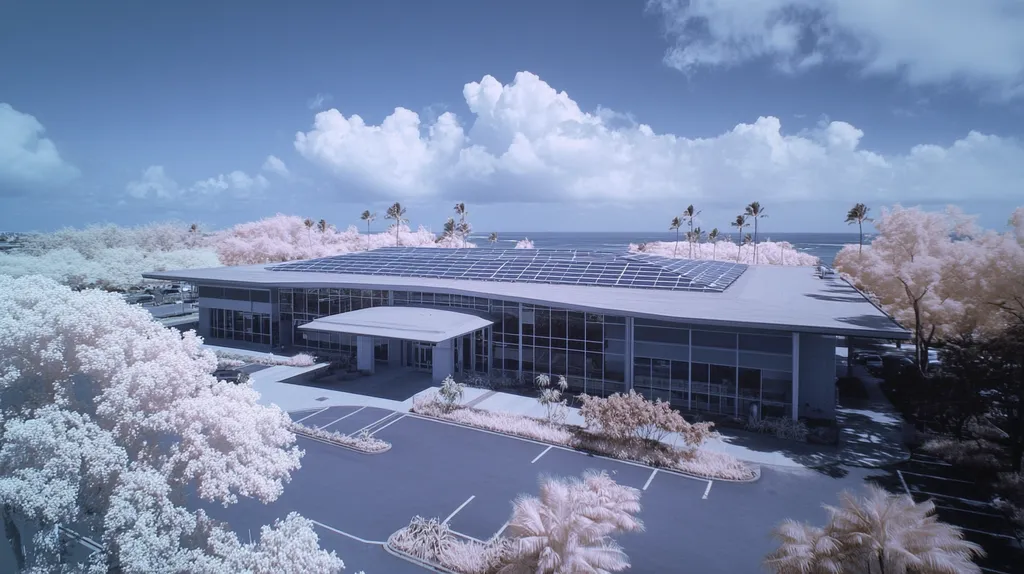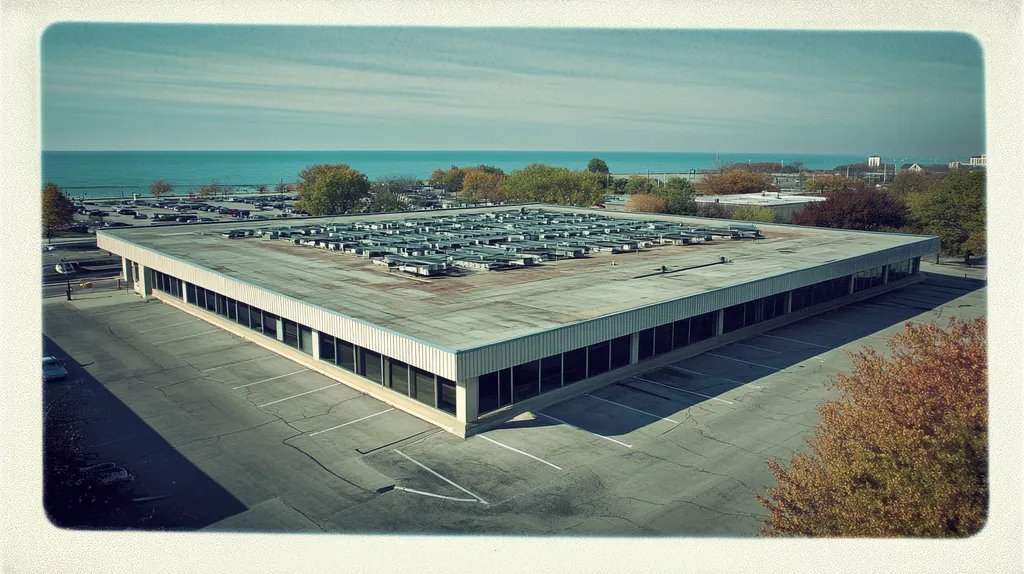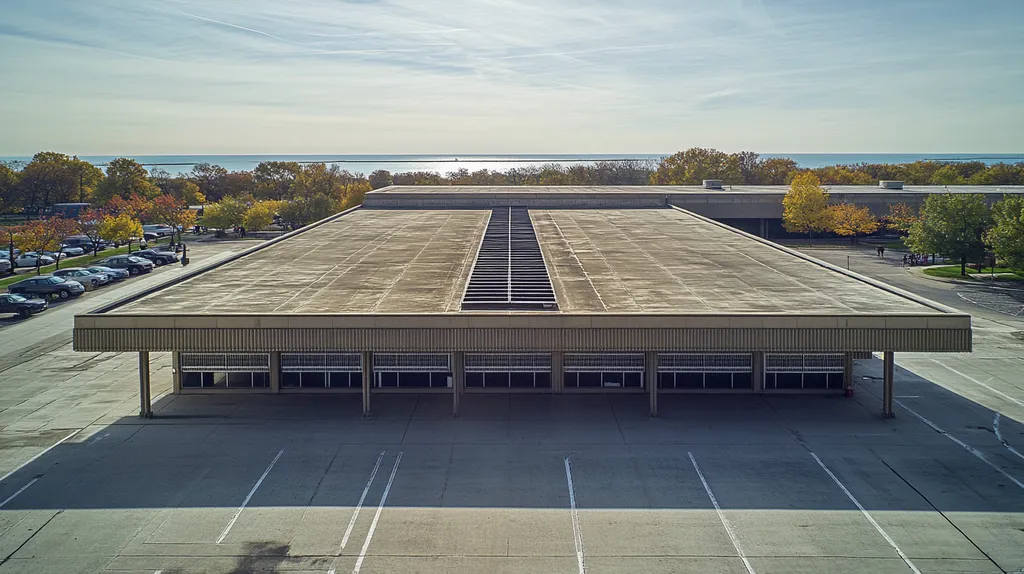Every year, commercial building owners lose millions to a silent menace lurking overhead – roof membrane leaks. Industry data shows that 40% of all flat roofs develop serious leaks within their first 5 years, yet most property managers still cling to outdated maintenance myths.
From believing new roofs are invincible to assuming DIY repairs will suffice, these misconceptions lead to costly damage that impacts building integrity, occupant safety, and bottom lines.
This guide examines six critical areas where outdated beliefs about commercial roof maintenance collide with reality, offering evidence-based solutions to protect your investment.
SECTION 1: COMMON MISCONCEPTIONS
Property owners often think that plunking down cash for a new roof means they’ve secured a leak-proof fortress overhead. However, studies reveal that almost 30% of new roofs experience leaks in just a few years! Misunderstanding roof maintenance can lead to substantial financial headaches down the road, as repair costs can spiral out of control. In this section, we’ll tackle three widespread misconceptions: the belief that new roofs are invulnerable to leaks, the notion that only age impacts roof integrity, and the assumption that DIY repairs can effectively solve roofing problems.
New Roofs Are Leak-Proof
Many believe that once their roof is newly installed, it is safe from leaks. The reality, however, is that multiple factors can still lead to water infiltration in even the freshest of roofs. From poor workmanship to inadequate flashing and material defects, leaks can emerge when least expected.
For example, if the seams of the roof membrane aren’t properly sealed during installation, they can become weak points. This opens the door for water to seep in, especially during heavy rains or snowmelt. A brand-new flat roof that develops standing water is prime for leaks to appear.
That’s why routine inspections and maintenance are critical—no roof is an exception. Property owners should prioritize regular evaluations to catch potential issues early, minimizing future damages.
While investing in top-notch materials and skilled contractors does help reduce leak risks, it’s crucial to recognize that even new roofs require vigilant upkeep. Staying proactive keeps the roof in tip-top shape for years to come.
Age is the Only Factor
A common myth is that the age of a roof is the sole predictor of its susceptibility to leaks. Although aging materials certainly can deteriorate, several other elements significantly influence a roof’s performance. Environmental conditions, maintenance habits, and the quality of materials are all key players in the lifespan of a roof.
Extreme weather events—think heavy rain, snow, or hail—can wreak havoc on a roof’s structural integrity. Even a relatively new installation can suffer damage that leads to leaks if it’s not well-maintained.
Neglecting regular inspections can let small issues fester, turning into expensive repairs. Building owners might be stuck dealing with hefty repair bills caused by lack of attention, rather than the roof’s age itself.
Implementing a comprehensive maintenance plan that factors in specific environmental challenges can greatly extend any roof’s lifespan. While age matters, it’s only one piece of a much larger puzzle that dictates roof health.
DIY Repairs Are Effective
Many property owners mistakenly think they can tackle roofing issues on their own, believing DIY repairs will suffice. However, what may seem like an easy fix could turn into a recipe for disaster. Improperly executed repairs can exacerbate existing problems, leading to far bigger headaches down the line.
Using the wrong materials or techniques can compromise the roof’s integrity. A quick patch job might seem efficient, but it could end up costing a lot more to correct the resulting damage.
Roofing professionals bring expertise, experience, and the right tools to accurately diagnose issues and apply effective solutions. Trusting their skills can save time and money, preventing small leaks from escalating into major failures.
Investing in professional services ensures that repairs are done correctly the first time, safeguarding the property’s value and dramatically reducing the risk of costly future fixes.
SECTION 2: PRACTICAL IMPLICATIONS
Leaks in commercial roof membranes can spell disaster for property owners. These pesky issues can lead to severe structural damage, costly repairs, and significant downtime. Did you know that approximately 30% of facilities report extensive damage due to roof leaks every year? Understanding the practical implications of these leaks is crucial, as they impact building integrity, occupant safety, and business operations alike.
Impact on Building Integrity
When roof membranes leak, the structural integrity of the entire building is at stake. Water infiltrating through a roof can weaken walls, ceilings, and insulation over time, transforming minor leaks into major structural failures if left unchecked.
A concerning example is water pooling on a flat roof, which can seep through seams and lead to rot and deterioration of essential support systems. The longer these issues go unaddressed, the more extensive the damage can become.
That’s why regular inspections and maintenance are paramount. Early detection allows property owners to tackle problems before they snowball into costly repairs, extending the lifespan of the roof and preserving its function.
Furthermore, proactively fixing leaks protects your building’s long-term value. Ignoring issues can result in hefty renovations or a lower resale value down the road.
Effects on Occupant Safety
Keeping occupants safe is non-negotiable, and roof leaks can create hazardous conditions. Accumulated water can cause slippery surfaces, leading to slip-and-fall accidents, or even pose electrical risks from exposed wiring.
Mold growth is another serious consequence of persistent leaks. Not only is mold a health risk, but it can also generate legal liabilities and disrupt workforce productivity.
Building owners should take a proactive stance when it comes to monitoring roof conditions. Regular inspections for mold, water stains, and damp areas can help mitigate any health risks.
Implementing safety measures, such as proper signage and rapid response protocols, is vital. Prioritizing occupant safety fosters a nurturing environment that reflects positively on the organization.
Disruption to Business Operations
Roof leaks can gridlock business operations, causing unplanned interruptions. Water damage often requires immediate attention, leading to unexpected closures and significant financial losses.
Imagine a retail store having to shut down part of its operations due to a roof leak—this not only disrupts sales but can also damage inventory, adding salt to the wound.
Moreover, prolonged repairs can erode customer trust and satisfaction. A business’s reputation can take a hit if patrons associate it with neglect and poor maintenance.
To keep disruptions at bay, businesses should consider robust roofing management strategies. Regular assessments and prompt repairs can address minor leaks before they grow into major concerns.
By actively prioritizing roof maintenance, organizations can safeguard their finances and maintain smooth operations, even in challenging conditions.
SECTION 3: COST OF MISINFORMATION
Leaks in commercial roof membranes are not just minor inconveniences; they often come with hefty financial repercussions that can catch property owners off guard. Alarmingly, nearly 60% of property owners underestimate the costs stemming from misinformation regarding roof maintenance. This lack of awareness can snowball into not only increasing repair expenses but also concealed damage that could be detrimental to a business’s operations. It’s crucial for property managers to grasp the real costs of neglecting proper roofing information to ensure informed decisions.
Financial Consequences of Neglect
Overlooking even minor leaks can quickly lead to severe financial strain. For example, a seemingly insignificant tear in a roof membrane can spiral into thousands of dollars in unforeseen expenses. When water breaches a building’s interior, the repairs often extend beyond simple patchwork to include damaged ceilings, insulation, and even vital structural components.
Furthermore, the misconception that roofs can last indefinitely without maintenance can lead to premature roof replacements. Property owners who delay necessary upkeep may find themselves facing complete membrane failure, demanding a full roof replacement—an expense that far exceeds regular maintenance costs.
Many property owners neglect to set aside a budget for routine inspections, wrongly believing that their roofs can remain unmonitored. This oversight can lead to escalating repair costs that would have been easily mitigated through proactive maintenance measures.
Ultimately, the financial implications of disregarding roof maintenance can quickly spiral out of control, underscoring the importance of early intervention for effective cost management.
Hidden Costs of Water Damage
Water damage can wreak havoc far beyond what is visually apparent, leading to significant financial consequences that often go unnoticed. When roof issues are ignored, leaks may set the stage for mold growth, structural rotting, and deterioration of electrical systems. Each of these elements introduces costly repairs and potential liabilities that could easily have been avoided.
Mold is a particularly insidious problem; it can threaten both occupants’ health and the building’s structural integrity. Removing mold often requires extensive and expensive remediation efforts that can escalate into tens of thousands of dollars.
Additionally, compromised structural materials may jeopardize the safety of the entire facility, leading to not only repair costs but also business disruptions that hinder revenue. For instance, a damaged roof may necessitate closing parts of a building for repairs, halting normal operations.
The hidden costs linked to water damage reinforce the necessity for timely information and prompt action, ensuring that potential problems are identified before they transform into significant financial burdens.
Increased Energy and Maintenance Costs
Misperceptions about roofing can lead to inflated energy and ongoing maintenance costs. A damaged roof often results in inadequate insulation, allowing conditioned air to escape and causing energy bills to skyrocket as HVAC systems work overtime to maintain comfortable temperatures.
Furthermore, the costs associated with regular maintenance can balloon when leaks and other issues are left unchecked. Reactive maintenance is typically costlier than proactive measures, as it often entails extensive work to address already existing damage.
As roofs age and leaks develop, property owners may find themselves frequently replacing components, further inflating related expenses while causing operational disruptions due to ongoing repairs.
Recognizing the impact of misinformation can empower property owners to take preventive steps. Being informed about appropriate roofing practices leads to better decision-making, reduced energy costs, and lower maintenance expenditures.
SECTION 4: REALITY CHECK
Leaks in commercial roof membranes can spring up unexpectedly, jeopardizing the integrity of a building and leading to escalating costs. A recent study shows that nearly 40% of commercial roofing failures result from preventable factors. This section dives into three key offenders behind these leaks: membrane issues and workmanship, drainage and gutter problems, and the dangers of ponding water and flashing failures.
Membrane Issues and Workmanship
Ensuring top-quality workmanship during roof installation is crucial for maintaining membrane integrity. Problems such as poor adhesion, unsightly wrinkles, or improperly sealed seams can create vulnerabilities that lead to leaks. Struggling to follow the manufacturer’s installation guidelines can set the stage for premature failures, making buildings susceptible to water infiltration.
Moreover, installing membranes in harsh weather conditions can complicate the situation further. Keeping strict installation standards isn’t just a suggestion; it’s a necessity. Attention to detail can mean the difference between a durable roof and costly repairs down the line.
Implementing regular inspections during the installation process can help catch errors early. Selecting certified contractors who are knowledgeable about proper materials and techniques is a smart move to prevent future leak issues.
Ultimately, investing in quality workmanship protects the roof’s lifespan and keeps the interior safe from damage. The payoff for such diligence is well worth it, as it can significantly reduce repair costs in the long run.
Drainage and Gutter Problems
Proper drainage is the unsung hero of every commercial roofing system. If gutters end up clogged or poorly designed, water can pool on the roof leading to leaks. Building codes often stipulate specific drainage solutions, but adherence isn’t always a given during installation.
When roofs are incorrectly sloped, the problems escalate. Without proper water flow towards drainage points, water accumulates, increasing the risk of leaks and membrane breakdown. Routine inspections and maintenance for drainage systems can safeguard against water-related damage.
Investing in high-quality gutters and downspouts is a proactive step that pays off over time. Ensuring free-flowing water off the roof can extend the life of the roofing membrane. Property owners should prioritize regular checkups to tackle any drainage issues before they catch them off guard.
The link between proper drainage and leak prevention is critical. Consistently addressing these challenges not only fortifies the roofing system but also boosts the overall efficiency of the building.
Ponding Water and Flashing Failures
Ponding water is a major headache for flat commercial roofs. Accumulated water can add excessive weight and strain on roofing membranes, heightening leak risks. When paired with flashing failures—where joints and penetrations aren’t properly sealed—the situation can turn dire.
Flashing plays a vital role in directing water away from vulnerable spots, such as vents and walls. If flashing becomes damaged or is incorrectly installed, extensive water infiltration can occur. That’s why it’s essential to regularly inspect flashing for signs of wear, like cracking or peeling.
Incorporating design strategies that reduce ponding can drastically lower leak risks. For example, tapered insulation can direct water toward drainage points, eliminating standing water and protecting membrane integrity.
Taking a proactive approach to address ponding and flashing failures can save building owners both time and money. Ensuring these components function correctly is essential for the overall health of the roofing system.
SECTION 5: EVIDENCE-BASED ALTERNATIVES
Leaks in commercial roof membranes can lead to significant financial losses, safety hazards, and property damage. In fact, water damage claims in commercial properties can exceed thousands of dollars annually. To protect their investment, property owners and facilities managers must adopt proactive measures. By emphasizing regular inspections, high-quality materials, and effective weather damage prevention strategies, they can tackle existing issues and bolster their roofs against future failures.
Regular Inspections and Maintenance
Regular inspections are essential for spotting potential issues before they spiral into costly leaks. Experts recommend inspecting roofs at least twice a year, especially following severe weather events. By doing so, property owners can identify and address minor problems like seam separations or membrane punctures early, saving money in the long run.
During these inspections, trained professionals evaluate the roof’s overall condition, focusing on vulnerable areas such as flashing and drainage systems. A solid maintenance plan should include debris removal, seam repairs, and checks for ponding water. Taking care of these concerns promptly enhances the roof’s lifespan and protects the building’s integrity.
Additionally, documenting inspection results helps track recurring issues, allowing for better planning of repairs. This proactive approach minimizes unexpected costs and guarantees that the roofing system remains in excellent condition. Ignoring inspection routines only increases the chances of severe damage and unplanned expenses.
Investing in regular inspections and maintenance isn’t just a best practice; it’s a vital strategy for safeguarding valuable assets. With committed care, property owners can significantly reduce the risk of leaks and extend the time between necessary roof replacements.
High-Quality Materials and Installation
Using high-quality materials for roof installations plays a vital role in avoiding leaks. While cheaper materials may be appealing initially, they can lead to higher expenses over time due to frequent repairs or premature replacements. Research shows that roofs constructed with premium materials boast better resistance to environmental stressors, effectively cutting down on leaks.
Moreover, hiring skilled professionals for installation is essential for optimal roof performance. Poor installation practices—such as inadequate sealing and weak attachment—are common culprits behind leaks. Ensuring that contractors are certified and experienced can dramatically lessen these risks.
Additionally, commercial roof systems should meet the specific performance needs of the building. For instance, single-ply membranes work best for lighter structures, while built-up roofs are better suited for heavier applications. Aligning the right roofing system with the building’s requirements ensures enduring protection against leaks.
Ultimately, investing in quality materials and proficient installation proves beneficial in the long term. Property owners can expect fewer service interruptions and unexpected costs, supporting the overall financial health of their buildings.
Preventative Measures Against Weather Damage
Implementing preventative measures against weather damage is crucial for preserving the integrity of commercial roof membranes. Factors like wind, hail, and UV exposure create vulnerabilities that can lead to leaks. Features such as effective drainage systems and wind-resistant designs are essential for combatting these challenges.
Furthermore, equipping commercial roofs with protective layers that reduce UV degradation is key. Reflective coatings not only improve energy efficiency but also extend roof life by blocking harmful ultraviolet rays. These coatings can lessen heat absorption, which helps minimize thermal expansion and contraction, often responsible for membrane wear.
Regular cleaning of gutters and drainage systems is equally important for preventing water accumulation, a leading contributor to leaks. Ensuring that water flows freely off the roof minimizes the risk of pooling that can damage the membrane over time.
Investing in weatherproofing measures can yield substantial long-term benefits, decreasing repair needs and creating a resilient roofing system. In an era of unpredictable weather patterns, these proactive strategies are vital to keeping commercial roofs leak-free.
SECTION 6: TEST AND VERIFY
Leaks in commercial roof membranes can quickly escalate from minor annoyances to major headaches. Industry studies show that nearly 50% of water-related damage stems from undetected roof leaks, resulting in costly repairs and prolonged downtime. To safeguard their investments and ensure smooth operations, property owners must implement effective testing and verification strategies. This section delves into cutting-edge moisture scanning technology, the importance of a systematic approach to leak detection, and the benefits of robust preventative maintenance programs.
Using Moisture Scanning Equipment
Moisture scanning equipment is a game-changer for early leak detection. With tools like infrared thermography, facility managers can spot hidden moisture within roof membranes without invasive procedures. This non-destructive testing method saves valuable time and reveals issues that may be invisible to the naked eye.
Implementing moisture scanning technology allows property owners to address leaks before they cause further damage. Regular inspections using these scanners can uncover moisture-filled areas during routine maintenance, significantly reducing the risk of crisis situations. Astonishingly, buildings that utilize moisture scanning report up to 30% fewer water-related issues.
To maximize the effectiveness of moisture scanning, it’s essential for property owners to collaborate with trained professionals. Accurate interpretation of moisture scan results leads to targeted repairs that fix the underlying cause rather than just putting a band-aid on the problem, ultimately prolonging the roof’s lifespan.
Incorporating moisture scanning into the maintenance routine creates a proactive culture within the organization. By prioritizing these inspections, property managers can effectively protect their assets, ensuring long-term sustainability and cost-efficiency.
Identifying Leak Sources Systematically
Systematic identification of leak sources is critical for effective roof issue resolution. A random approach often leads to recurring problems without addressing the root cause. By employing a methodical investigation process, property owners can accurately trace leaks back to their origin.
Common techniques include visual inspections, following water paths, and examining vulnerable areas like seams and flashings. Using a checklist during inspections enhances consistency and thoroughness, ensuring that no detail is overlooked. This systematic approach minimizes disruption by limiting repairs to affected areas only.
Keeping a detailed log of previous repairs and inspections is another key tactic. This documentation helps recognize patterns and identify potential problem areas. Over time, specific trends may emerge that highlight leaks related to environmental factors or material fatigue.
Collaborative inspections with roofing professionals add immense value to the process. Such joint assessments provide a comprehensive understanding of the roof’s condition and align maintenance goals, ultimately leading to reduced repair costs and improved building safety.
Implementing Preventative Maintenance Programs
Preventative maintenance programs are the cornerstone of extending the lifespan of commercial roof membranes. These forward-thinking strategies enable property owners to identify and address issues before they develop into significant leaks. Experts recommend establishing a robust maintenance schedule that includes regular inspections and prompt repairs.
Property owners should also educate their teams on environmental conditions that can compromise roof integrity. Factors like heavy snow loads or damaging UV rays can accelerate wear and tear on membranes. Regular maintenance not only tackles these concerns but also reduces business interruptions due to unexpected repair needs.
Incorporating technology, such as drones for aerial roof inspections, enhances the preventative approach. This innovative technique provides a safe and comprehensive view, identifying potential trouble spots while delivering valuable data for informed decision-making.
Ultimately, a strong preventative maintenance program fosters a sense of responsibility and care within the organization. By prioritizing roof health, property owners can save significant costs in the long run, ensuring their buildings remain safe, functional, and well-maintained.
The Bottom Line
With over $3.7 billion lost annually to commercial roof leaks, property owners can no longer afford to perpetuate outdated maintenance myths.
Industry data shows that 40% of all commercial roof failures stem from preventable causes, primarily due to inadequate maintenance and delayed responses to early warning signs.
By implementing regular professional inspections, utilizing moisture detection technology, and maintaining detailed maintenance records, building owners can extend roof lifespans by up to 60%.
The choice is clear: continue reactive practices that lead to costly repairs and business disruptions, or adopt evidence-based maintenance strategies that protect both property values and occupant safety.
The future of commercial roofing lies not in responding to leaks, but in preventing them through systematic, technology-driven maintenance programs.
FREQUENTLY ASKED QUESTIONS
Q. Are new commercial roofs really leak-proof?
A. Many property owners believe that their new roofs are immune to leaks. In reality, factors like improper installation and material defects can still lead to leaks, even on brand-new roofs. Regular inspections and maintenance are essential to catch potential issues early and ensure the longevity of your investment.
Q. How do leaks affect my commercial roof’s integrity?
A. Roof leaks can undermine the entire structure of your building over time. Water intrusion can weaken walls, ceilings, and insulation, leading to more extensive structural damage. Regular maintenance and inspections are crucial to preventing these kinds of costly repairs and protecting your building’s overall integrity.
Q. What are the financial repercussions of roof misinformation?
A. Underestimating maintenance needs can lead to substantial repair costs. Minor leaks, if left unaddressed, may escalate into major repairs or total roof replacements, which can be incredibly expensive. Staying informed about proper roofing practices can help mitigate these risks and save money in the long run.
Q. What common issues cause leaks in commercial roofs?
A. Common culprits of leaks include poor workmanship, inadequate drainage systems, and ponding water. These problems can exacerbate wear and tear on the roof membrane, making it susceptible to leaks. Addressing these key areas through proper installation and regular maintenance can significantly reduce risk.
Q. How can high-quality materials prevent leaks?
A. Using high-quality materials significantly enhances the durability of commercial roofs. Cheaper materials may save money initially but can lead to frequent repairs and premature replacements. Investing in quality ensures better resistance to elements, thus preventing potential leaks and extending the roof’s lifespan.
Q. Why is preventative maintenance important for commercial roofs?
A. Preventative maintenance is essential for extending roof life and preventing leaks. Regular inspections can catch minor issues before they escalate into significant repairs, minimizing unexpected costs. A robust maintenance schedule helps protect your investment and ensures the roof continues to perform optimally.
Q. What are effective ways to detect roof leaks?
A. Utilizing moisture scanning technology and systematic leak detection techniques can effectively identify issues. Regular inspections focusing on vulnerable areas allow for early detection, reducing the chance of a leak turning into a costly repair. Collaborating with roofing professionals enhances the accuracy of these inspections.

